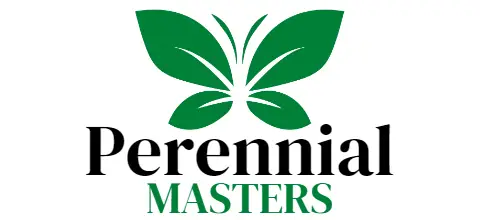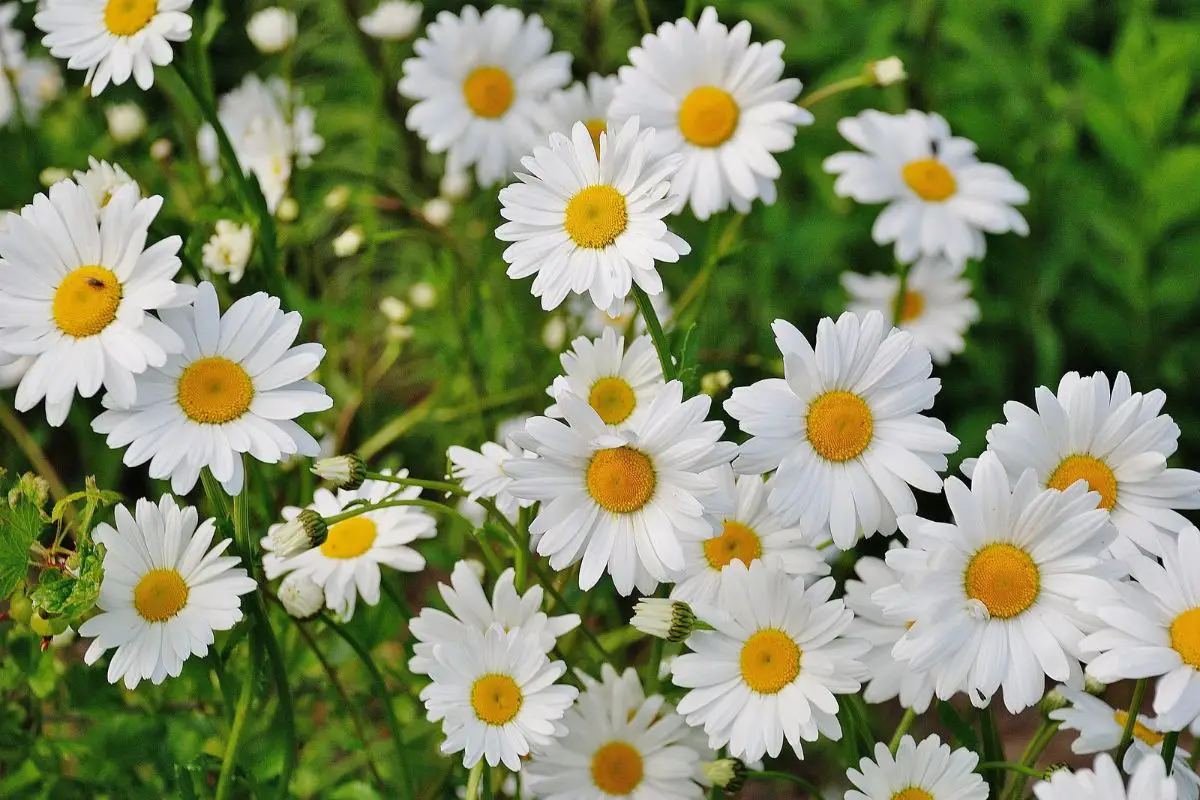Perennials are versatile plants that cover a broad spectrum of uses, growing conditions, and colors. The individual characteristics of perennials give us an equally broad palette when designing our gardens using them for height, texture, and color. In both form and function.
Witnessing the spectacular show these plants give us over the growing season and sometimes throughout the summer is enough to make any plant lover a fan of perennials. And the best part is they do this year after year.
Table of Contents
Summer Perennials
Perennials that bloom all summer add vitality and cheerfulness to our gardens with their bright color and striking appearance. Some of these long-blooming summer favorites are allium, shasta daisy, bee balm, coreopsis, lilies, and daisies just to name a few.
How Long Do Perennials Bloom?
One of the differences between annuals and perennials is their bloom time. With a little care, annuals will produce blooms all season long. Of course, the downside of that is that they only last for one season.
While many perennials only bloom for a couple of weeks, you can find a wide selection of these plants that bloom for several months. When laying out your garden you want to take into consideration the height of the plant, the color of the foliage and flowers, the time of year these flowers bloom, and the duration of the flowers.
With some forethought, you can have a garden that displays excellent color all season long. From early spring to late fall, there will be a flowering perennial to fit your needs.
Do Perennials Bloom More Than Once?
Some perennials will naturally bloom more than once per season. Specialized breeding in nurseries and garden centers has created new varieties of short-blooming perennials that are now repeat bloomers.
Many of these are hybrids that were developed especially for this purpose. Several species of roses, some hydrangeas, and several vining plants like honeysuckle vines are common rebloomers.
Many of the flowers on our list will also be repeat bloomers giving them a combined bloom time of several months. We suggest deadheading spent blooms to encourage more growth. Also, using a fertilizer with more phosphorus and less nitrogen will encourage blooming.
Now let’s take a closer look at our list of perennials that bloom all summer.
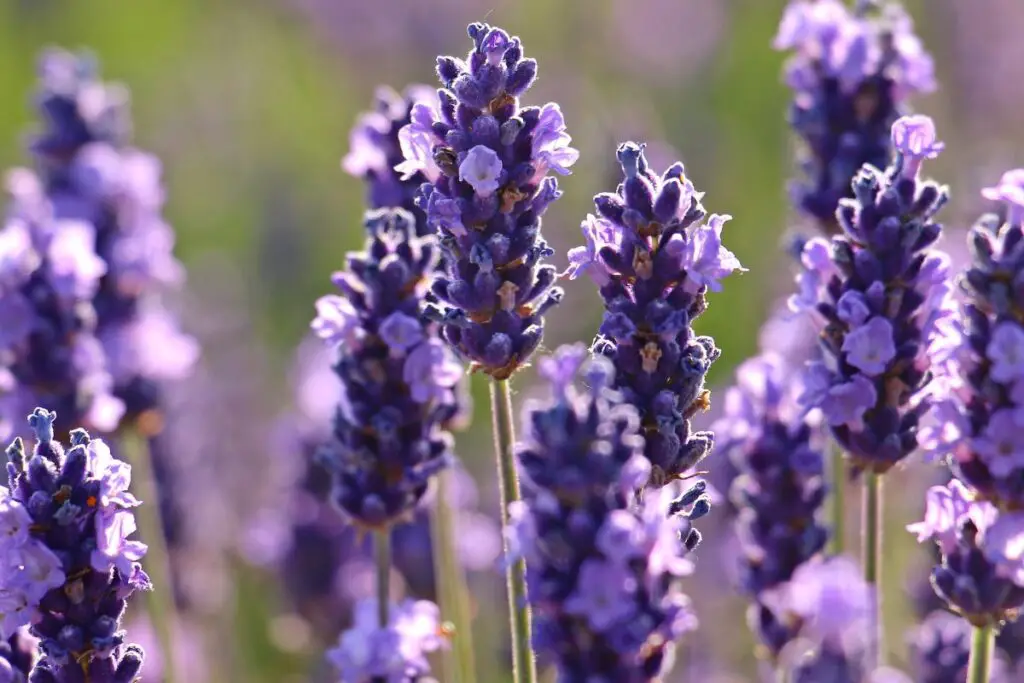
Lavender
Lavender is in the mint family and is more than just a beautiful fragrant plant. It is also used as an herb for medicinal and therapeutic treatments. Lavender has the ability to bloom all summer.
- Growing Zones 5-9
- Full sun
- Height 20-24”
- Spacing 20-24”
Want to see more purple flowers? Check out Purple Perennials
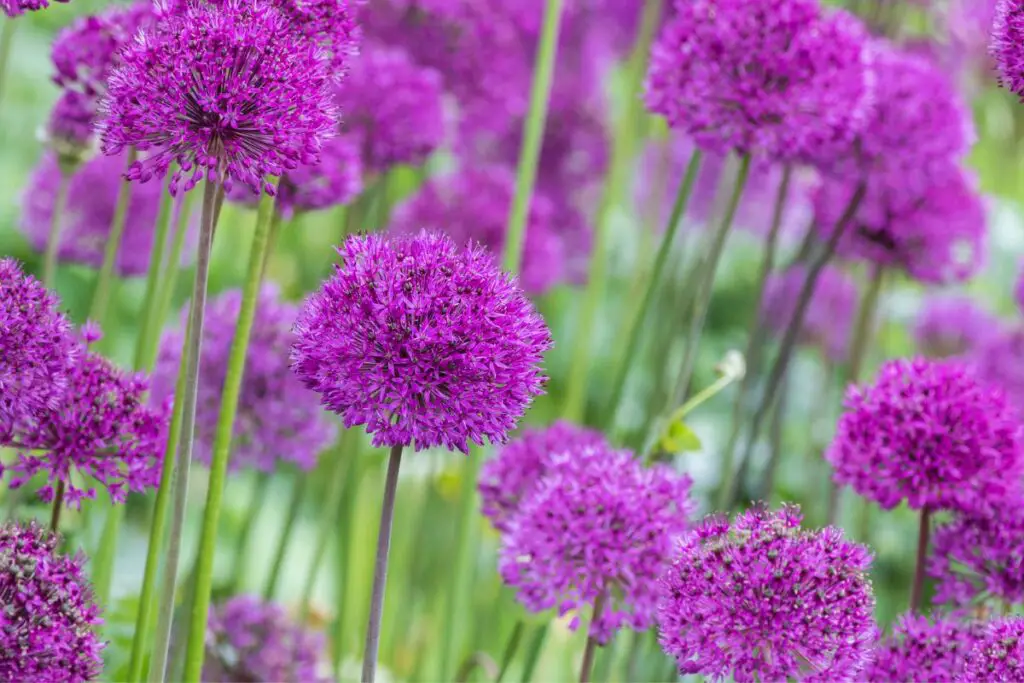
Allium (Ornamental Onion)
Allium is a genus of plants that include onions, chives, garlic, and leeks. The spherical blooms are made of hundreds of individual petals mostly purplish-pink, but they also come in white, blue, and yellow. These perennials bloom throughout the summer season.
- Growing Zones 3-9
- Full Sun
- Height 12-36”
- Spacing 3-18”
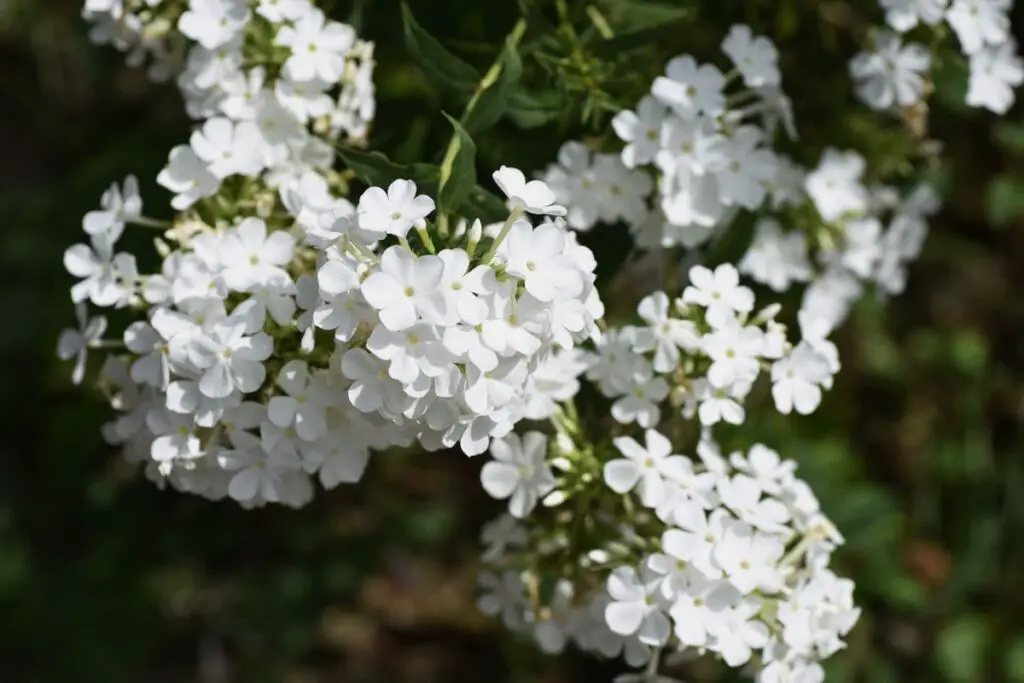
Phlox
Phlox prefer rich, moist soil and are wonderfully fragrant. Many varieties are native to North America and attract birds and butterflies. They are low maintenance and come in many types from ground cover to tall and medium-height varieties. These are great perennial bloomers for the summertime!
- Growing Zones 3-8
- Full Sun to Part Shade
- Height 2-4’
- Spacing 2-3’
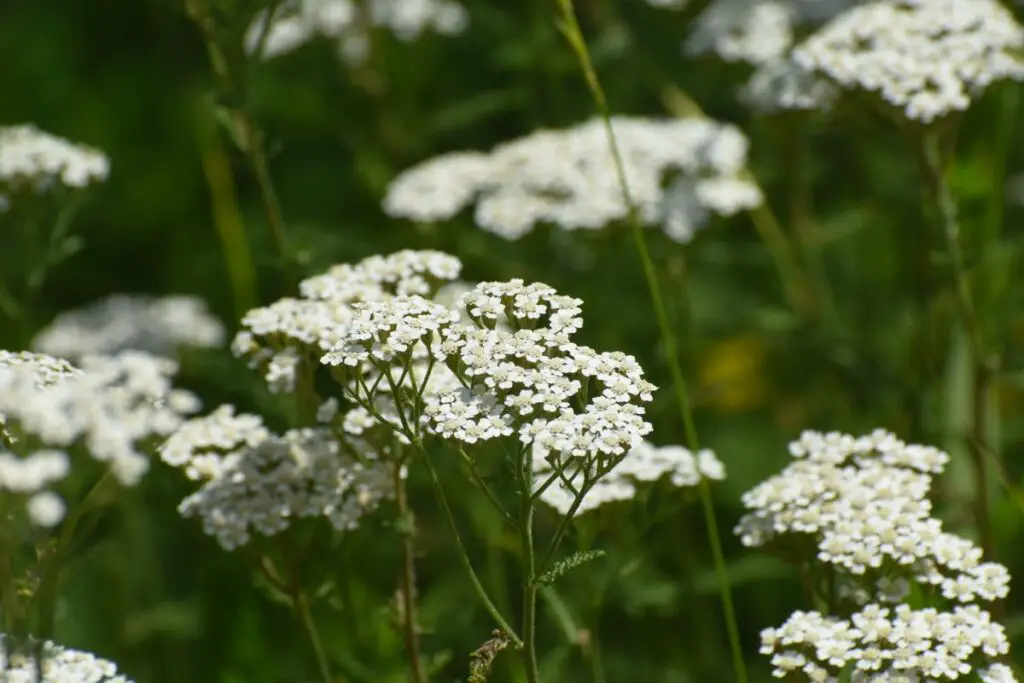
Yarrow (Achillea)
Yarrow comes in many colors and is a low-maintenance, drought-resistant plant that attracts butterflies. It can be an aggressive grower and should be planted with some caution. However, when properly cared for it can bloom all summer long!
- Growing Zones 3-9
- Full Sun
- Height 2-4’
- Spacing 1-2’
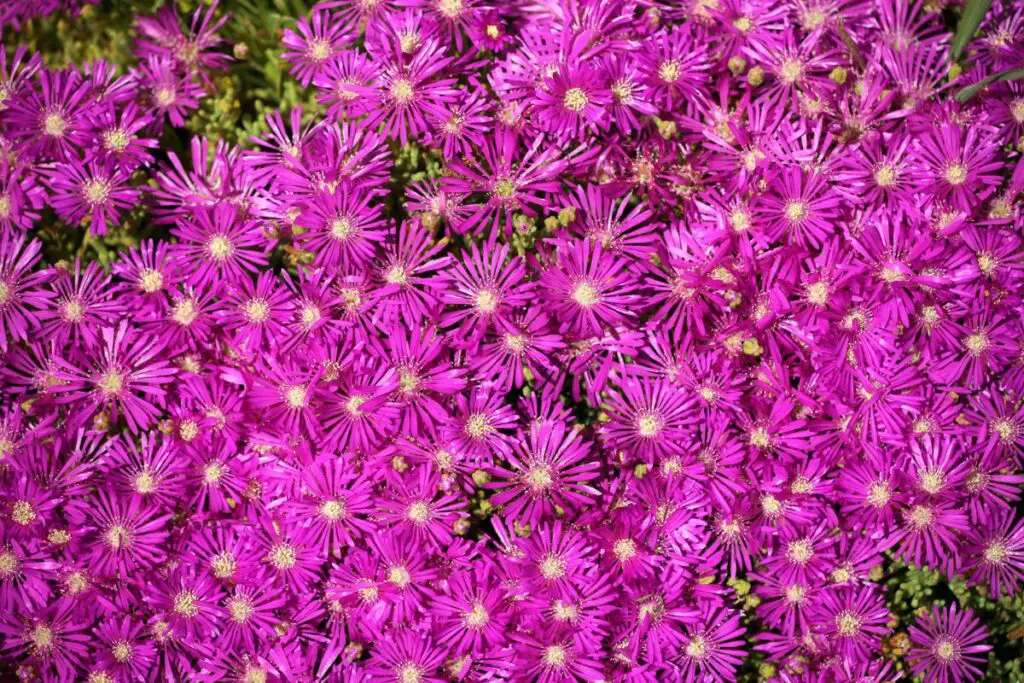
Ice Plant
Ice plants are versatile garden plants with lovely flowers. These plants are cold-sensitive so check the growing Zones before planting. When it comes to the summer though, they bloom very well!
- Growing Zones 6-10
- Full Sun
- Height 3-6”
- Spacing 12-24”
Shasta Daisy
This herbaceous perennial will bloom from spring to fall with some repeat blooming. It attracts butterflies and is deer and rabbit-resistant, drought-tolerant, and has few pests and diseases.
- Growing Zones 5-9
- Full Sun
- Height 1-2”
- Spacing 12-18”
Autumn Joy Stonecrop
Also known as sedum, Autumn Joy stonecrop is a hybrid of sedum and ice plant. It is a hardy plant that is drought-tolerant and will last for many years with little care. It blooms during the summer months and looks amazing.
- Growing Zones 3-9
- Full Sun
- Height 18-24”
- Spacing 2-3’
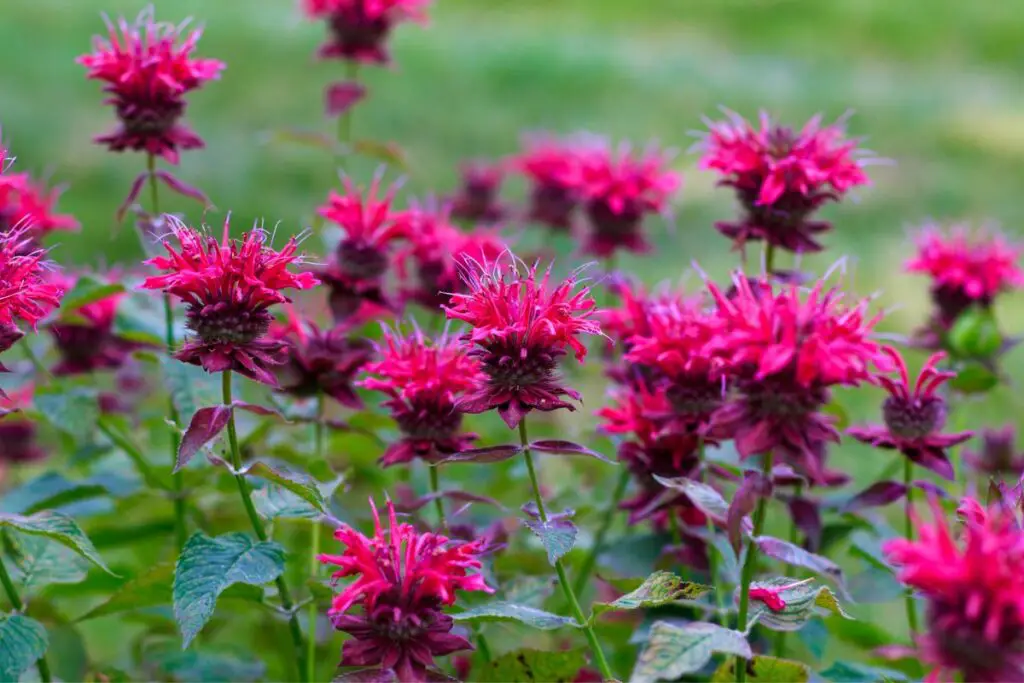
Bee Balm
Bee balm has a very interesting flower and is great for pollinators. Another native perennial, it has beautiful blooms and fragrant foliage. Divide these plants every 2-3 years to keep them looking full. You expect them to bloom during the summer!
- Growing Zones 3-9
- Full Sun
- Height 3-4’
- Spacing 18-24”
Butterfly Bush
Butterfly Bush is a perennial shrub with many cultivars available for different uses. They are considered in many areas to be dangerously invasive. It is advised for gardeners to choose non-seeding varieties. Butterfly bush has blooms during the summer months.
- Growing Zones 5-9
- Full Sun
- Height 3-12’
- Spacing 5-10’
Catmint
Very similar to catnip, catmint puts on more blooms and has more ornamental value in the garden. Catmint, flowers in early summer with white, pink, or lavender flowers that will bloom repeatedly throughout the season.
- Growing Zones 4-8
- Full to Partial Sun
- Height 10-24”
- Spacing 18”
Hardy Hibiscus
Native to North America, the hardy hibiscus has large flowers with ruffled petals. The flowers attract hummingbirds and butterflies and come in white, red, pink, and blue. These flowers bloom in the summer and look great with their large flowers.
- Growing zones 4-9
- Full Sun
- Height 3-7’
- Spacing 2-3’
Birch Hybrid Bell Flowers
Great for groundcover or rock gardens, Birch Hybrid bellflowers produce a mass of beautiful violet-blue, bell-shaped flowers from late spring to late summer. Though there are many great bellflowers, the Birch Hybrid is one that won’t disappoint.
- Growing Zones 4-9
- Full to Partial Sun
- Height 4-6”
- Spacing 12”
Black-eyed Susan
Black-eyed Susan is native to eastern North America and attracts butterflies, bees, and other beneficial insects. They are low-maintenance plants that are deer and drought-resistant. Black-eyed Susans bloom through the summer!
- Growing zones 3-9
- Full to Partial Sun
- Height 2-3’
- Spacing 18”
Perennial Geranium
There are literally hundreds of species and cultivars under the genus name Geranium. They have few pests and are cold hardy, usually up to zone 3. To get a second flush of flowers, shear back after the first blooms fade. You can expect them to bloom all summer.
- Growing Zones 3-9
- Full Sun to Partial Shade
- Height 6-12”
- Spacing 8-12”
See our article for Hardy Perennials here
Daylily
Daylily flowers come in orange, pink, purple, red, white, and yellow. Easy to grow, these plants are bothered by few pests and diseases, are drought-tolerant, and thrive under varied light and poor soil conditions. They can grow great during the summertime.
- Growing Zones 4-9
- Full Sun
- Height 1-4’
- Spacing 18”-3’
Purple Coneflower
Purple coneflowers are repeat bloomers that start to bloom at the beginning of summer and flower all the way until the first real frost. These drought-tolerant prairie plants are native to North America and attract pollinators and birds.
- Growing Zones 3-8
- Full Sun to Partial Shade
- Height 2-5’
- Spacing 2’
Lilies
Lilies are herbaceous perennials that grow from bulbs. Though many other plants bear the term ‘lily’ in their name, they are not true lilies.
Hybrids and cultivars are available to grow in your garden which have the most beautiful flowers and are easy to grow. Values given below will work for many but all will vary by species. Lilies are a great flower to bloom during the summer season.
- Growing Zones 3-9
- Full sun to Full Shade
- Height 3-6’
- Spacing 8-18”
Coreopsis
Another wonderful native plant that is a must-have in the garden is coreopsis. There are more than 75 varieties of coreopsis, and some of them are even annuals. These perennials bloom during the summer months and are a great addition to your garden.
- Growing Zones 2-11
- Full Sun
- Height 2-4’
- Spacing 12-18”
Salvia
Salvia is part of the mint family and the herb, sage, is actually a type of salvia. Although that variety does not have much ornamental value and is not usually grown in flower gardens. Many are not tolerant of cold weather and are grown as annuals in northern parts of the country. They bloom in the summer.
- Growing Zones 5-10
- Full Sun
- Height 12-24”
- Spacing 1-3’
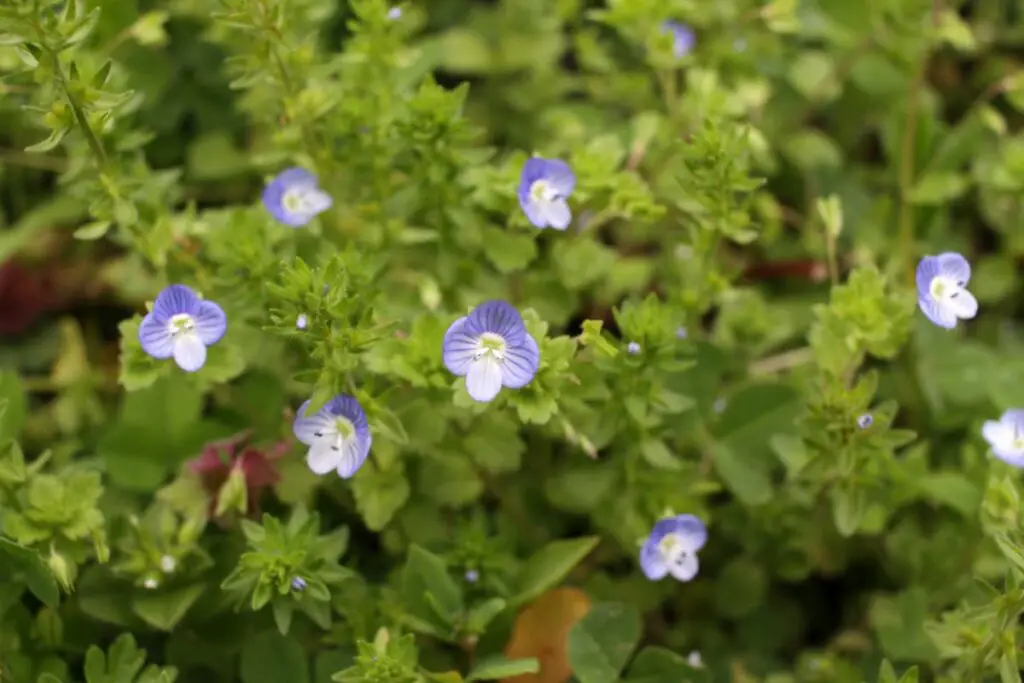
Veronica
Also called speedwell, Veronica attracts birds, bees, and butterflies. There is also a low-growing variety (Veronica prostrata) that makes excellent ground cover and grows well in crevices. Veronica has blooms during the summer months.
- Growing Zones 3-11
- Full Sun
- Height 1-3’
- Spacing 10-20”
Agastache (Hyssop)
Agastache comes in many splendid colors from blue, red, orange, and white to light pink and dark purple. Mostly native to North America, this plant is beloved by pollinators. You can expect this perennial to bloom all summer.
- Growing Zones 3-10
- Full Sun
- Height 3-5’
- Spacing 12-215”
Clematis
Clematis is a long-lived perennial vine also known as the “Queen of the Vines”. There are hundreds of species ranging from vines to shrubs and trailing types. They are native to North America and prefer a stationary structure to climb.
Clematis is another great pollinator plant, hummingbirds, bees, and butterflies will be attracted to their blooms. This is one of my favorite perennials that bloom all summer.
- Growing Zones 4-8
- Full Sun
- Height 20-30’ (Vines)
- Spacing 24-36”
Corydalis
Corydalis is native to the temperate regions of the northern hemisphere and has a history of being used as an herbal medicine in India, China, and Europe as well as North America by Native Americans. A member of the poppy family, it is also related to bleeding heart. Corydalis has amazing blooms during the summer.
- Growing Zones 5-7
- Shade to Partial Sun
- Height 12-18”
- Spacing 9-12”
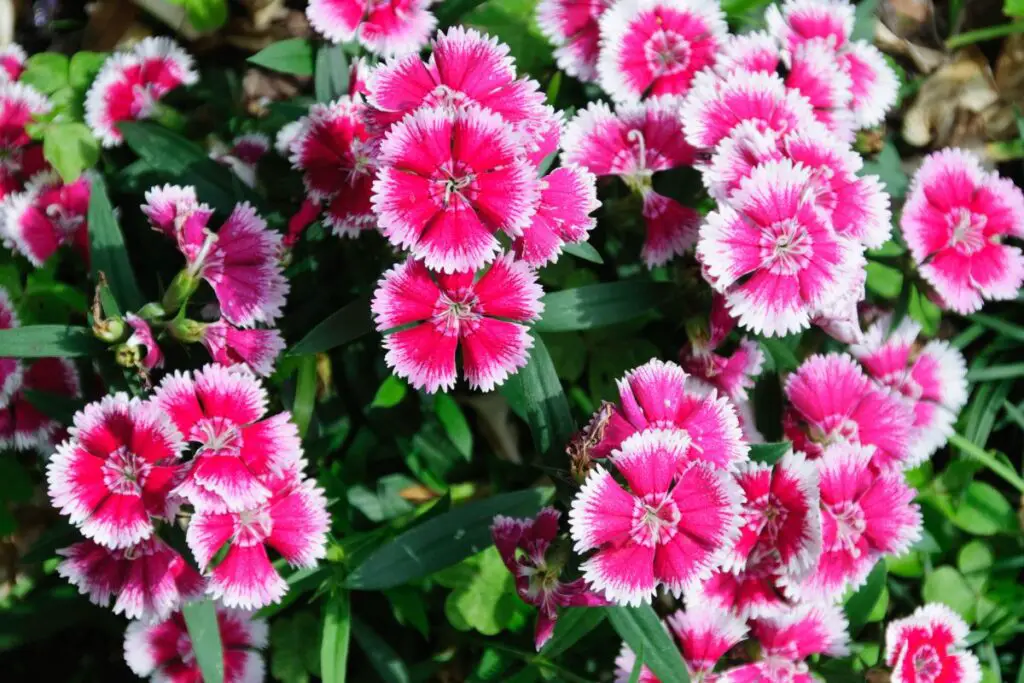
Dianthus
Also known as “pinks”, their flowers are not only beautiful but wonderfully fragrant as well. Deadhead the flowers, including stems, all the way to the base of the plant to keep them blooming all summer long. Their lovely fringed blossoms and serrated edge can’t be beaten.
- Growing Zones 4-9
- Full Sun
- Height 2-24 (Depends on variety)
- Spacing 6-12”
Daisy
There are many types of daisies that you can grow in your garden. They readily self-seed and some are considered invasive so check with your local county extension office if you are unsure as to which type you have.
Your local nursery should be able to help you with this as well. Values below will vary greatly depending on which one you choose to grow. A good place to start is with the ever-popular Shasta Daisy. Daisy bloom through the summer.
- Growing zones 4-9
- Full Sun
- Height 1-4’
- Spacing 24-30”
Guara
Known for its long bloom time, guara has white, pink, or a combination of the two flowers. Native to North America, these plants also feature attractive foliage of lance-shaped leaves that are tinged with cream, gold, or pink as well as stems that are a shaded red color. Guara has blooms during summertime.
- Growing Zones 5-9
- Full Sun
- Height 15-48”
- Spacing 12-15”
Honeysuckle
The honeysuckle family includes 180 species and should be used with caution as some are highly invasive. The common honeysuckle is native to Europe, North Africa, and western Asia. Hummingbirds and bees love their flowers and the plant has blooms during the summer months.
- Growing Zones 4-10
- Dappled Sunlight
- Height 12-20’
- Spacing 3-5’
Milkweed
Milkweed is essential to the monarch butterfly. The monarch butterfly larvae and caterpillars feed exclusively on their leaves. Remove the seed pods before they open to reduce spreading to unwanted areas. Milkweed has blooms through the summer.
- Growing Zones 3-9
- Full Sun
- Height 2-4’
- Spacing 18”
Viola
Plants in the genus Viola can be annuals or perennials and there are over 500 species. Types of violas to try in your garden include the garden pansy, Johnny-jump-up, and the wild blue violet. Violas have blooms in the summer months.
- Growing Zones 3-8
- Full to Partial Sun
- Height 4-10”
- Spacing 4-6”
Want to learn more about perennials? Check out Do Perennials Come Back Every Year
In Conclusion
These are some of our favorite perennials that bloom all summer. The great thing about the plants on our list is that most of them are easy to grow and good for beginners.
Other long-blooming perennials that will add color to your garden all summer long are Russian sage, pincushion, sunflower, cup plant, and Joe Pye weed.
